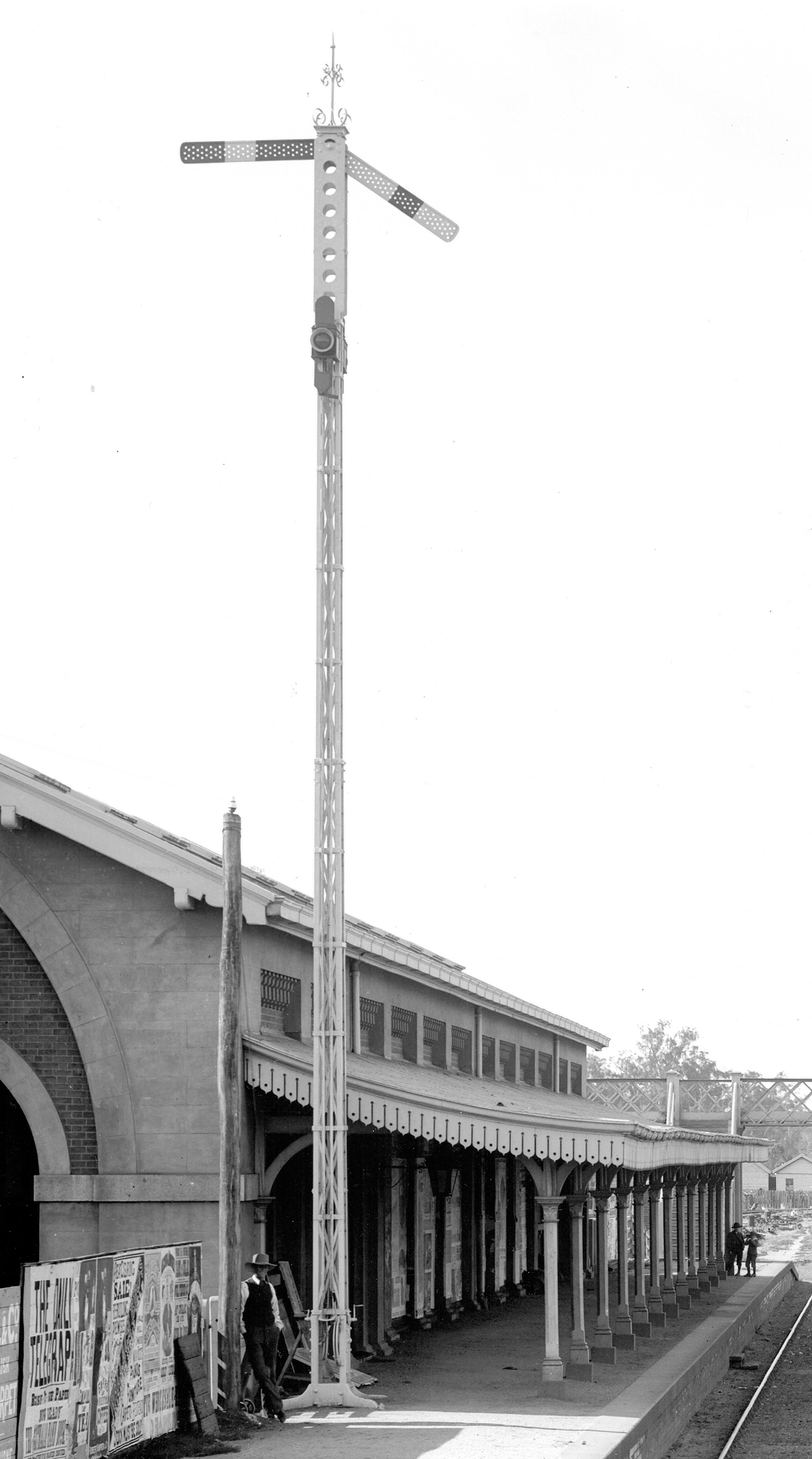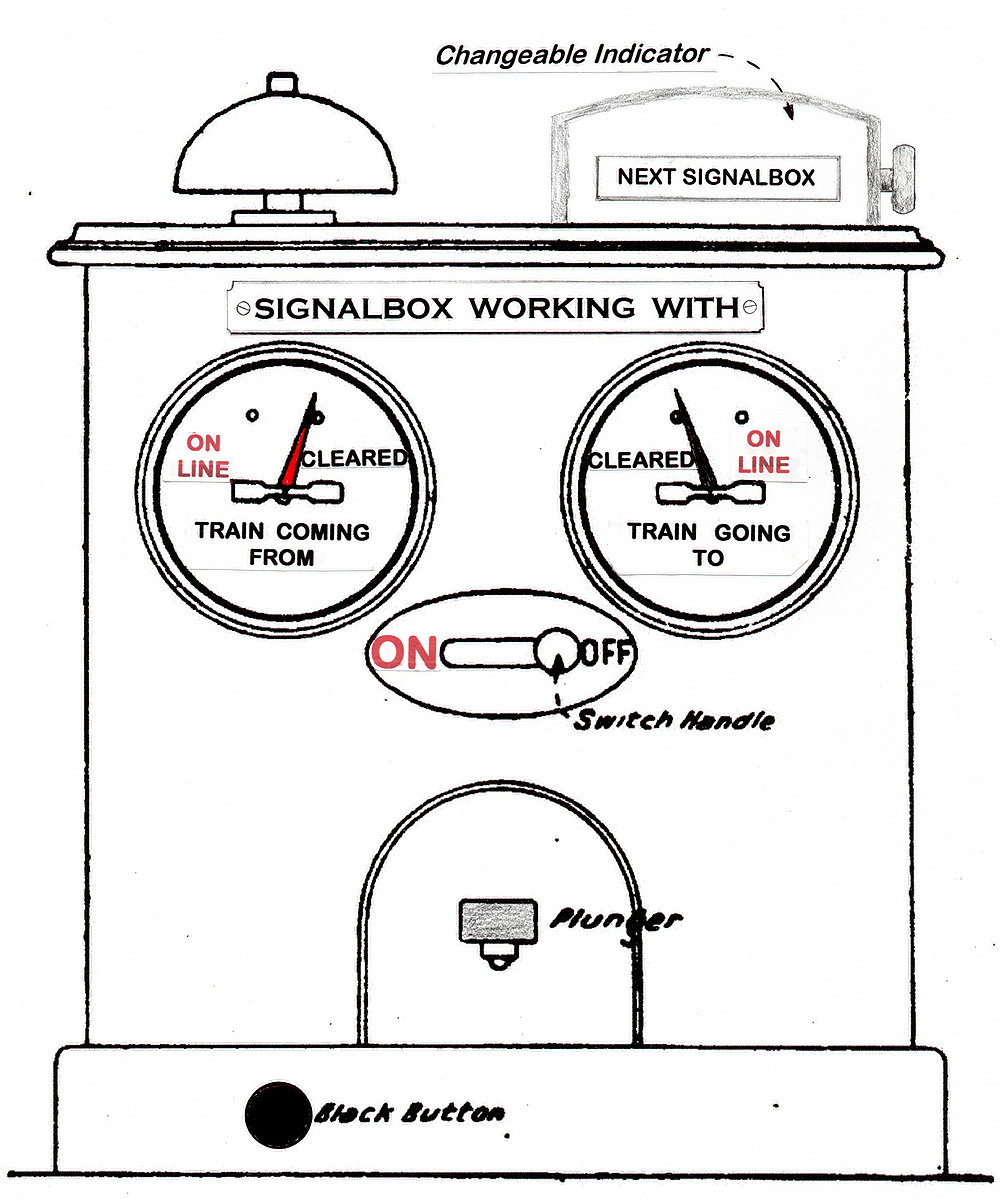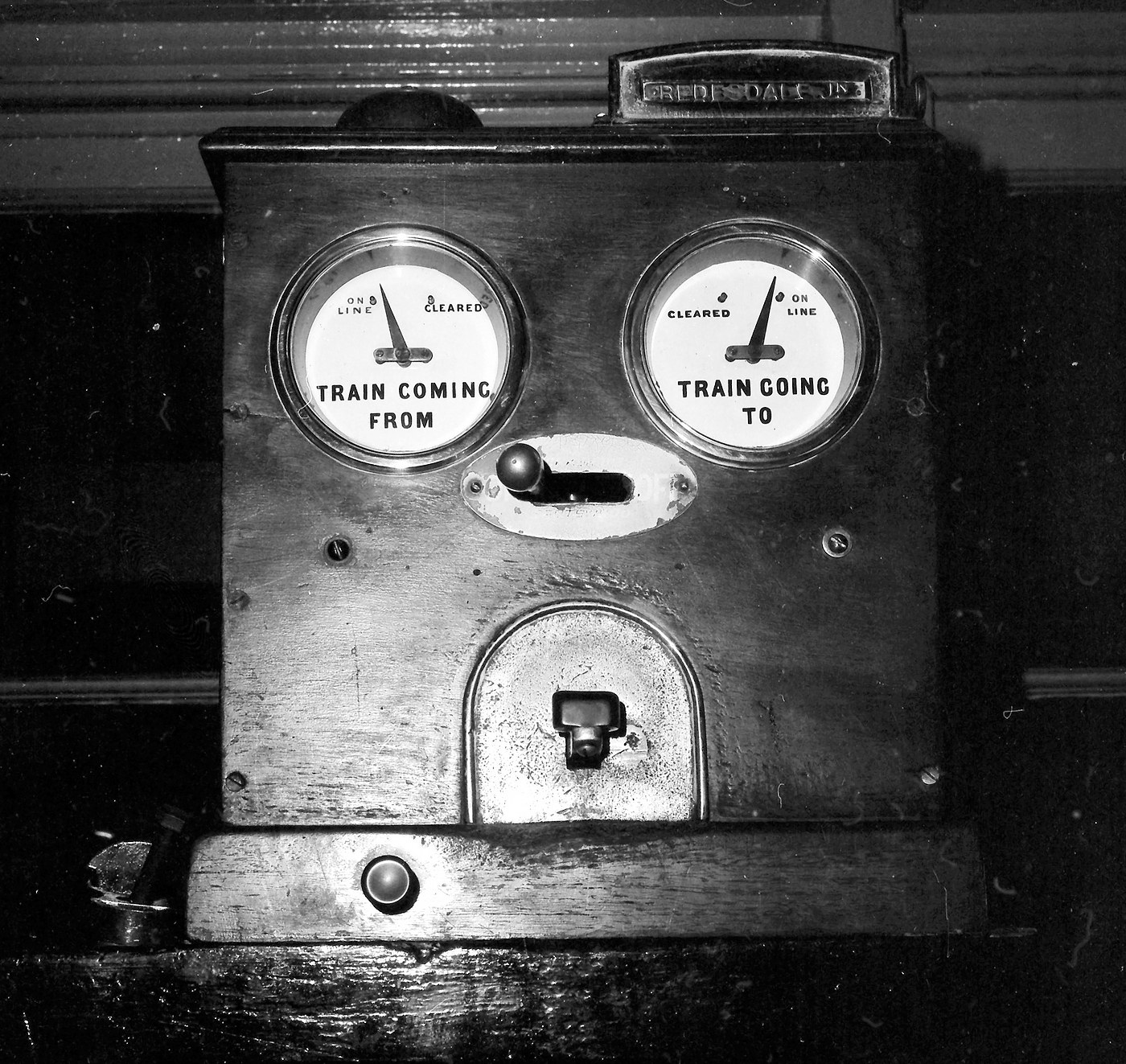
Signalling on Double Lines
FROM TIME INTERVAL TO DOUBLE LINE BLOCK
Article written by Chris Wurr, with additional content by Geoff Winkler
Methods employed by the Victorian Railways (and its predecessors, the private companies) of preventing trains colliding with each other, in the early years were extremely primitive. The basic “safeworking” principle in use was strict adherence to the times shown in the Service Timetable. Timetables were the visible means of deciding when and where trains departed, arrived, crossed each other, ran through or shunted aside. Regulation 14 of the 1864 VR Rule Book stipulated that all servants of the railway were to have a copy of the Service Timetable with them at all times whilst on duty. Time Bills were used for extra trains which were not laid down in the Service Timetable, but were required to run, perhaps at short notice. This was the genesis of the familiar Special Train Notices board fixed on the outside wall of every station. It was accessible to all employees regardless of grade and available for perusal at any time of the day, whether the station be open for business or closed. Reg.51 warned employees to be mindful that engines could possibly be running on the line at any time, but not be shown in timetables or Time Bills. Of course trains would never be able to adhere to the times shown in 100% of cases and so the Time Interval system was superimposed on the Service Timetable for trains following one another. It must be kept in mind, that at this time, telegraphic communication was by no means available between each and every station or location on the burgeoning rail system. In fact prior to 1st January 1878, the telegraph system (incomplete as it was along the state’s railways) was actually the property of the Victorian Postal Department. Locations not connected to the telegraph were totally reliant on the Service Timetable and observing train head and tail signals, as well as verbal advice from train crews to be informed of following or opposing train movements. This was made even more difficult by the fact that most lines were still single at that stage. Trains were not permitted to depart before the time shown in the timetable or bill.
Time Interval Working
In the cases of trains running in the same direction, distance between them was regulated by the times shown in the Service Timetable. And when a following train was advancing on a preceding one, an interval of time was to be maintained between them at stations and locations. This was achieved by the use of Station Semaphore signals. These comprised a single post, usually placed centrally within the station limits, with single arms and lights facing trains in both directions. The arm was pivoted at the post and was constructed to be able to disappear from view into a vertical slot in the signal post. The light worked in conjunction with the arm. The arms worked in the lower lefthand quadrant on either side of the post to signal Up and Down direction trains from the one signal post. The arms were set by the Stationmaster or other appointed employee, using a hand lever in the three positions, located at the base of the signal post.
Time Interval system worked in the following manner:
Engine Drivers would sound the whistle when 400 yards out from a signalled location. Upon arrival of a train at a station, the Station Semaphore was placed at the Danger position ----- arm (in the direction of travel) horizontal and the lamp displaying a red light. Five minutes after departure of the previous train, if the line was observed to be clear, the semaphore arm was lowered to the Caution position (about 45 degrees below horizontal) and the spectacle in front of the lamp changed to display a green light. After a further five minutes duration, if all was seen to be OK, the arm was lowered to disappear into the slot in the post and at the same time the green spectacle was raised clear of the lamp lens, thus displaying the “white” light of the lamp.
 Click image for larger version.
Click image for larger version.
Regs. 197, 198 and 199 of the VR 1864 book stipulate 15 minutes between departing trains at certain locations on the Mainline and the Buninyong line.
Reg.53 explained:
Red is a Signal of Danger to Stop.
Green is a Signal of Caution to Slacken Speed.
White is a Signal of All Right to Go on.
It must be remembered that the colour yellow for use in signal lenses, was a long way from being perfected and reliable as a night indication in these early times. Handlamps (kerosene or battery) in use on the railways of Victoria up until very recent times, show only red, green or white and the indications those colours convey are the same as those ancient station semaphores.
The running of following extra trains was announced to all employees by the display of a red “board” or second red tail light on the rears of preceding trains and all employees were implored to check all passing trains for them. Until the occupation of Guard was eliminated starting in the 1980s, the folding tail disc which was part of his kit displayed white on one side and red on the other --- a hark back to the old days. As for working trains in either direction over single line sections, the 1864 book merely stated under Reg. 205 that care must be taken before any train is despatched from a station, to see that there are no opposing trains and to use the telegraph where provided!
Train Signal Books were used at all signalling locations to keep a record of train movements and times, but of course where there was no telegraph between locations, the Signalman/Stationmaster had no information as to the arrival (or otherwise), of the any trains he had sent into the section.
One of the early apparent shortcomings of this form of Signalling, was the absence of any protection for trains that remained at a station for a prolonged length of time, whether stationary or performing shunting operations. The solution for this was the provision of additional Semaphore signals on the approach sides of stations, it is presumed that these were single sided, and applied in the one direction only. Being located outside the immediate station environs, their operation was usually performed remotely via a wire cable. As such they were referred to as Distant or Distance signals, and bore no relation to the Distant signals we know of today. Trials were also carried out for their operation using Electro-Magnetic technology, but very little detail of this is known at present.
It is inferred in snippets of correspondence, that these signals became quite widespread across the system, but definitive locations have not as yet been identified. Officially, they were called an ‘Advanced Semaphore’, being located in the advance of or before a Station Semaphore. This too became quite an anomaly, as subsequently with the introduction of a new Rule book for the Victorian Railways in 1884, the term ‘Advance’ came to refer to something as being behind or after.
Of utmost importance was the protection of trains brought to a stand between locations, and Reg.279 mandated that the Guard provide this with the utmost haste. Telegraphic communication on the VR’s lines was taken over from the postal department and extended to cover the busiest lines, following formation of the Telegraph Branch on 1st January 1878. This paved the way for far safer and more flexible train working.
DOUBLE LINE BLOCK, using Winter's Block
Following trials conducted during 1883, major State-wide alterations to safeworking occurred early in 1884. The earliest documented evidence at hand of this, appeared in the Government Gazette of February 1, 1884. A copy of a new Victorian Railways Rule book published within it, had all references to the use of three position ‘Station Semaphore’ and ‘Advanced Semaphore’ signals removed, along with the universal use of the system of ‘Time Interval’ working. (View it online here).
As from that point in time, Fixed signals consisted of 6 types only, being Junction, Distant, Home, Starting, Advanced Starting and Siding. All of these displayed only 2 indications, being “Danger” and “All Right”. It was insinuated and is most probable that until replacement, the original Semaphores were retained and used, with modified operation; The vertical position of the arm was removed and the “All Right” was now shown by the arm “hanging down to the side of the post”, (being lowered 45 degrees).
The telegraph system by then had been improved to such an extent that signals which controlled the entrance of trains into an onward section, were to be kept at Danger “until telegraph information had been received….that the preceding train or engine has passed out of the section”. This was known as “Telegraph Block”, and was the forerunner to the introduction of absolute block signalling on double lines. Absolute meaning one train ONLY on the line between signalling locations, rather than the imprecise system afforded by timetable and Time Interval.
Such absolute train signalling systems were being developed in the UK and its colonies during the 1870s. George Kift Winter was the Telegraph Superintendent of the Madras Railway Co. in India and around 1878 invented a two-position block telegraph instrument which could be utilised to control train movements over both double and single lines. This was patented in conjunction with James Craik, the Madras Rly Co’s Assistant Traffic Manager in June 1880 combined with optional Starting signal control through the instruments. The operation of the system was possibly being monitored in India as early as July 1881 and later, about March 1882 in New Zealand, by the VR’s Telegraph Engineer Kynaston Lathrop Murray. He seems to have recommended the adoption of Winter’s block for double line working on the VR, although in New Zealand the system was at that time only applied experimentally to single line working.
Subsequently the VR installed the system (without Starting signal control) commencing in October 1883, over nine sections between Flinders Street and Balaclava. The precise date is still subject to some conjecture.
Consequent upon the adoption of block telegraph working, signals progressed from Station Semaphores to the now familiar two-position Distant/Home/Starting signals configuration. Initially the Proceed aspect by night, was still conveyed by a white light, however circa 1898 the green light aspect was converted to. A green light now indicated Proceed ---- line ahead is clear. The white All Right indication formerly used on Station Semaphores could understandably be confused with white lights from nearby houses, etc and so the adoption of a green light was far safer and more easily identifiable.
Winter’s Block instruments comprise a wooden cabinet on which are mounted: a single stroke bell, two dials with one needle each, a horizontally moveable Switch Handle, a tapping Plunger key and a Black press Button.
 Click Image for larger version.
Click Image for larger version.
The name of the signalling location at the opposite end of the section with which this instrument is always working is displayed on a plate fixed to the front of the cabinet. However if the next location is able to switch out or in, then a changeable indicator is fixed to the top of the instrument to allow the Signalman to rotate the indication to the name of the signalbox being worked with.
Kyneton to Redesdale Jcn. block instrument:
 Click image for larger version.
Click image for larger version.
The Double Line Block system works in the following manner.
Referring to the drawing of a Winter’s block instrument, say a train was to run from Signalbox A, through the double line section to Signalbox B.
The Signalman at A would Call Attention to the Signalman at B by tapping the Plunger on his instrument once. A beat on the tapping Plunger at one end of the section causes the bell at the opposite end of the section to strike once.
The Signalman at B would respond by tapping his plunger once.
Signalman A would then ask Is Line Clear for whatever type of train was to be advanced. Different trains had a different combination of bell beats. See Code of Bell Signals HERE. Let’s say A wants to send on a Livestock train. He bells 4 pause 1 on the tapping Plunger to B.
If the line is clear between the locations and there is no other reason preventing the train from advancing, then B will put his Switch Handle to ON and repeat the 4 pause 1 bell signal back to A.
Signalman A gives one beat on the bell and presses the black button at the same time. The black needle at A and the red needle at B will then point to On Line.
A is then permitted to clear his Starting signal for the train to depart into the section towards B.
As the train is departing, Signalman A sends Train Departure to B by 2 beats on the Plunger. B acknowledges departure by repeating the 2 beats.
The train now has complete authority to occupy the block section between the two signalboxes. When the train arrives or passes B the Signalman will observe that the train is complete by the exhibition of a white tail disc or single red taillight at night on the rear of the least vehicle. This ensures that the train has not become parted somewhere in the section. Signalman B then places his Switch Handle to OFF and sends 3 beats on the bell to Box A to signify Train Arrival. Signalman A acknowledges this by repeating the 3 bells and at the same time pressing the Black Button on his instrument. This causes the indicator needles on the instruments in both signalboxes to move to Cleared.
The section is now clear and available for another train to pass through. Under Victorian Railways Double Line Block Rules, there were 35 Rules pertaining to all aspects of its operation.
Winter’s Block eventually worked double lines over much of the Victorian main line system. The last still in use (as at January 2022) is between Craigieburn and Seymour, however continued theft of copper wire from the line wires which connect the sections, has lead to the system being conducted over the telephone.
FOOTNOTE: Winter’s Block was also worked in conjunction with Train Staff & Ticket on the single line between Everton and Beechworth until 30th June 1953 when both systems were replaced with Electric Staff. The reason for superimposing Single Line Block over T.S&T. was that in the Up direction from Beechworth to the junction at Everton, was 9¼ miles of continuous downhill track, most of which was at 1 in 30 gradient (nominally the steepest gradient in the state) and that in the early days at least, trains getting out of control were a possibility. The sending of bell signals on the block instruments kept the Signalman at Everton, right up to date with the movements of trains, thus preparing him for safe (or otherwise) arrivals at the junction.
Additionally, prior to the extensive introduction of Electric Staff on single main lines from April 1897, Single Line Block working using Winter’s instruments was also to found over some sections of Train Staff & Ticket.
BELOW: This diagram shows a typical signalling arrangement for stations on Double Lines. The key signal is the Starting signal as this is the authority for a train to enter the section between two stations. The distant signal could not be placed to proceed unless the home and starting signals were at proceed. Note that there are no facing points at either station. This was a direct import of standard British practice on double lines whereby all points, except at junctions, were trailing points. When the Lancefield line was still operational this meant that a down train going onto the branch had to set back from the down platform onto the up line and then pull ahead through the Up platform in order to diverge onto the branchline. Trailing points were not interlocked with the signals. At some locations the use of facing points was unavoidable, such as at Carlshrue, in which case the signals were interlocked with the facing points.

